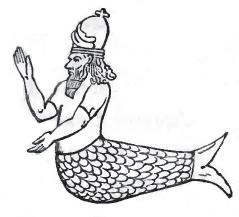well as her fishy tail, indicate her nature; she was not, perhaps, a native of the sea, but a stream-dweller, and therefore as closely related to the true mermaid of the briny deep as are the fresh-water fish to those of the salt sea.
The superstitious belief in mermaids is universal, and I frankly confess my inability to account for its origin in every case. In some particular cases the origin of the myth is clear, in others it is not so. Let me take one which can be explained—the Oannes of the Chaldæans, the Philistine Dagon.
Oannes and Dag-on (the fish On) are identical. According to an ancient fable preserved by Berosus, a creature half man and half fish came out of “that part of the Erythræan sea which borders upon Babylonia,” where he taught men the arts of life, “to construct cities, to found temples, to compile laws, and, in short, instructed them in all things that tend to soften manners and humanize their lives;” and he adds that a representation of this animal Oannes was preserved in his day. A figure of him sporting in the waves, and apparently blessing a fleet of vessels, was discovered in a marine piece of sculpture, by M. Botta, in the excavations of Khorsabad.

{{c|Oannes, from Khor
